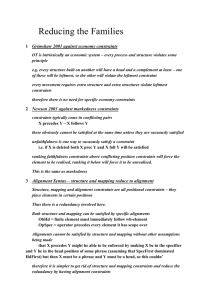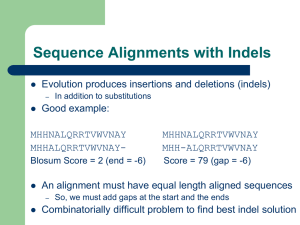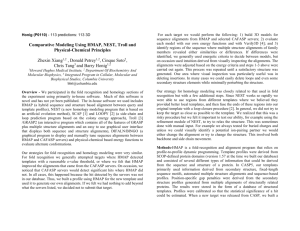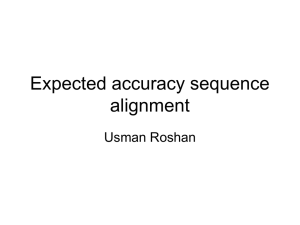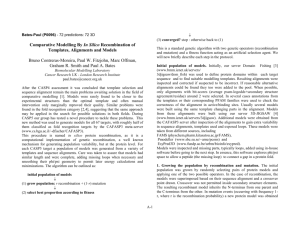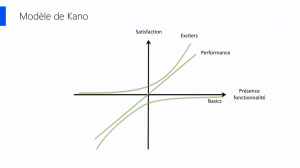Document
advertisement
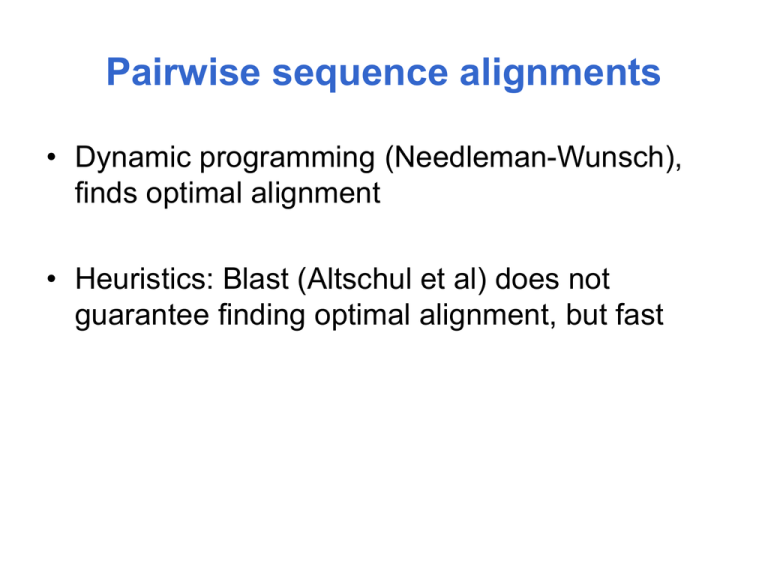
Pairwise sequence alignments
• Dynamic programming (Needleman-Wunsch),
finds optimal alignment
• Heuristics: Blast (Altschul et al) does not
guarantee finding optimal alignment, but fast
Pairwise sequence alignments
APLFVA----ITRSDD
APVFIAGDTRITRSEE
Assumptions:
- evolution of sequences through mutations and
deletions/insertions;
- the closer similarity between sequences, the more
chances they are evolutionarily related.
Similarity measures: Percent Identity
Identity score – Exact matches receive score of 1 and non-exact
matches score of 0
AVLILKQW
AVLI I LQ T
-----------------------------1 1 1 1 0 0 1 0 = 5 (Score of the alignment under “identity”)
Percent identity: identity_score/length_of_the_shorter_protein
Disadvantage of % id: does not take into account the similarity
between their properties.
Substitution Matrices – measure of “similarity”
score of amino-acids
• M(i,j) ~ probability of substituting i into j over some time
period
• Percent Accepted Mutation (PAM) unit = evolutionary time
corresponding to average of 1 mutation per 100 res.
• Two most popular classes of matrices:
– PAMn: relates to mutation probabilities in evolutionary interval of n
PAM units (PAM 120 is often used in practice)
– BLOSUMx: relates to mutation probabilities observed between
pairs of related proteins that diverged so above x % identity.
BLOSUM62 ~ PAM250
Scoring the gaps
The two alignments below have the same score.
The second alignment is better.
ATTTTAGTAC
ATT- - AGTAC
ATTTTAGTAC
A-T-T -AGTAC
Solution: Have additional penalty for opening a gap
Affine gap penalty
w(k) = h + gk
; h,g constants
Interpretation: const of starting a gap: h+g, extending gap: +g
Dot plot illustration
T
A
C
T
C
A
T
T
A
C
T
A
C
T
C
A
A
Adapted from T.
Przytycka
T
The alignment
corresponds to path
from upper left corner
to lower right corner
going trough max. nr
of dots
Deletions
TTACTCAAT - - - - ACTCA- TTAC
Gap penalties
Consider two pairs of alignments:
ATCG
ATTG
AT - C - T A
AT T T T TA
and
and
AT – C G
AT T - G
ATC - - T A
ATT T T TA
They have the same score
but the right alignment is
more likely from
evolutionary perspective
(simpler explanation =
better explanation)
• First problem is corrected by introducing “gap penalty”: for each gap
subtract gap penalty from the score
• Second problem is corrected by introducing additional penalty for opening
a gap:
Affine gap penalty
w(k) = h + gk
; h,g constants
Interpretation: const of starting a gap: h+g, extending gap: +g
Organizing the computation – dynamic
programming table
Align
j
Align(i,j) =
Align(Si,S’j)= max
i
{
Align(Si-1,S’j-1)+ s(ai, a’j)
Align(Si-1,S’j) - g
Align(Si,S’j-1) - g
+s(ai,aj)
max
Recovering the path
A
A
T
G
C
ATTG AT- G C
T
T
G
Ignoring initial and final gaps – semiglobal
comparison
CAGCA - CTTGGATTCTCGG
- - - CAGCGTGG - - - - - - - -
No penalties for
these gaps
Recall the initialization step for the dynamic programming table:
A[0,i], A[j,0] – these are responsible for initial gaps.
set them to zero!
How to ignore final gaps?
Take the largest value in the last row /column and trace-back form there
Comparing similar sequences
Similar sequences – optimal alignment has small number of gaps.
The “alignment path”
stays close to the
diagonal
From book Setubal Meidanis”Introduction Comp. Mol. Biol”
Local and global alignments
Global
Local
Local alignment (Smith - Waterman)
So far we have been dealing with global alignment.
Local alignment – alignment between substrings.
Main idea: If alignment becomes too bad – drop it.
a[i,j]= max
{
a[i-1,j-1]+ s(ai, aj)
a[i-1,j +g
a[i,j-1]+ g
0
Example
BLAST
•
•
•
•
Local heuristics
Fast
Good statistics
Precalculated lookup table of all high score word
matches of three residue long
• Extend the hit until score drops below some
threshold
Sequence-profile alignments: sequence profiles
describe conserved features with respect to position
in multiple alignment
1 2 3 4 5 6 7
--------------------------------------A
2 -2 -2 -1 -1 -1 -2
--------------------------------------R -3 -2 -3 -3 -2 -2 -4
--------------------------------------N -3 1 -4 -4 -2 -2 -4
--------------------------------------D -3 7 -4 -4 -3 -3 -4
--------------------------------------C -2 -4 -2 -1 -2 -1 6
---------------------------------------.
IDVVVVC
LDLV--C
LDLVFVC
ADIIFLI
Gribskov et al, PNAS, 1987;
Schaffer et al, Nucleic Acids
Res., 2001
Computational aspects of protein
structure
Examples of protein architecture
β-sheet with all pairs
of strands parallel
Architecture refers
to the arrangement
and orientation of
SSEs, but not to the
connectivity.
β-sheet with all pairs
of strands anti-parallel
Examples of protein topology
Topology refers to
the manner in which
the SSEs are
connected.
Two β-sheets (all
parallel) with different
topologies.
Secondary structures are connected
to form motifs.
G.M. Salem et al. J. Mol. Biol. (1999) 287 969-981
Supersecondary structure: Greek
key motifs
G.M. Salem et al. J. Mol. Biol. (1999) 287 969-981
Some supersecondary structure motifs
are associated with specific function:
DNA binding motifs.
Helix-turn-helix motif:
recognizes specific palindromic
DNA sequence
Zn-finger motif: Zn binds to two
Cys and two His; binds in
tandems along major groove
P-loop motif.
Sequence pattern: G/AxxxxGK(x)S/T
Function: mononucleotide binding
Calcium-binding motif.
Calcium-binding sequence pattern:
DxD/NxDxxxE/DxxE
Function: binding of Ca(2+);
calmodulin: Ca-dependent signaling pathways
A.Lewit-Bentley & S. Rety, 2000
Protein domains can be defined based on:
• Geometry: group of residues with the high contact
density, number of contacts within domains is higher
than the number of contacts between domains.
- chain continuous domains
- chain discontinous domains
• Kinetics: domain as an independently folding unit.
• Physics: domain as a rigid body linked to other domains
by flexible linkers.
• Genetics: minimal fragment of gene that is capable of
performing a specific function.
Domains as recurrent units of proteins.
• The same or similar domains are found in different
proteins.
• Each domain has a well determined compact structure
and performs a specific function.
• Proteins evolve through the duplication and domain
shuffling.
• Protein domain classification based on comparing their
recurrent sequence, structure and functional features –
Conserved Domain Database
Conserved Domain Database (CDD).
•
Protein domain classification
based on comparing their
recurrent sequence, structure and
functional features – Conserved
Domain Database
•
CDD represents a collection of
multiple sequence alignments
corresponding to different protein
domains
CDD icludes a set of multiple sequence
alignments.
• Accurate alignments since structure-structure
alignments are reconciled with sequence
alignments.
• Block-based alignments.
• Annotated alignments.
• Annotated functionally important sites.
PSSMs for each CDD are calculated using
observed residue frequencies and relationships
between different residue types.
1 2 3 4 5 6 7
--------------------------------------A
2 -2 -2 -1 -1 -1 -2
--------------------------------------R
IDVVVVC
LDLV--I
LDLVFVI
ADIIFLI
-3 -2 -3 -3 -2 -2 -4
--------------------------------------N -3 1 -4 -4 -2 -2 -4
W(D,3) = log( Q(D,3) / P(D) )
--------------------------------------D -3 7 -4 -4 -3 -3 -4
P(D) – background probability
---------------------------------------
Q(D,3) – estimated probability
for residue “D” to be found in
column 3.
C
-2 -4 -2 -1 -2 -1
6
--------------------------------------.
.
.
How to annotate domains in a protein
using CDD?
• To annotate domains in a protein:
- to find domain boundaries
- to assign function(structure) for each domain
• For each query sequence perform CD-search.
• CD-search: query sequence is compared with sequence
profiles derived from CDD multiple sequence alignments.
Classwork
• Retrieve 1WQ1 from MMDB, look at structural
domains and domains annotated by CDD. How
different are they?
• Pretend you do not know the structure of 1WQ1,
perform the CD-search, annotate domain
boundaries.
Protein folds.
• Fold definition: two folds are similar if they have a similar
arrangement of SSEs (architecture) and connectivity
(topology). Sometimes a few SSEs may be missing.
• Fold classification: structural similarity between folds is
searched using structure-structure comparison
algorithms.
• There is a limited number of folds ~1000 – 3000.
Superfolds are the most populated
protein folds.
• There are about 10 types of
folds, the superfolds, to which
about 30% of the other folds are
similar.
•Superfolds are characterized
by a wide range of sequence
diversity and spanning a range
of non-similar functions.
C.Orengo et al, 1994
Why do some folds are more populated
than others?
•
•
•
•
•
Thermodynamic stability?
Fast folding?
By chance, through the duplication processes?
Perform essential functions?
Symmetrical folds, emerged through the gene
duplication?
• High supersecondary structure content, higher
fraction of local interactions?
Distinguishing structural similarity due
to common origin versus convergent
evolution.
Divergent evolution, homologs
Convergent evolution, analogs
TIM barrels
•
Classified into 21 families in the CATH database.
•
Mostly enzymes, but participate in a diverse collection of different
biochemical reactions.
•
There are intriguing common features across the families, e.g. the
active site is always located at the C-terminal end of the barrel.
Catalytic and metal-binding residues aligned in structure-structure alignments
Nagano, C. Orengo and J. Thornton, 2002
Functional diversity of TIM-barrels.
TIM barrel evolutionary relationships
• Sequence analyses with advanced programs such as
PSI-BLAST have identified further relationships among
the families.
• Further interesting similarities observed from careful
comparison of structures, e.g. a phosphate binding site
commonly formed by loops 7, 8 and a small helix.
• In summary, there is evidence for evolutionary
relationships between 17 of the 21 families.
SCOP (Structural Classification of
Proteins)
• http://scop.mrc-lmb.cam.ac.uk/scop/
• Levels of the SCOP hierarchy:
–
–
–
–
Family: clear evolutionary relationship
Superfamily: probable common evolutionary origin
Fold: major structural similarity
Class: secondary structure content
CATH (Class, Architecture, Topology,
Homologous superfamily)
• http://www.biochem.ucl.ac.uk/bsm/cath/
Classwork
• Using SCOP and CATH classify four protein
structures (1b5t, 1n8i, 1tph and 1hti).
• How different are the classifications produced by
SCOP and CATH?
• Can these proteins be considered homologous?
